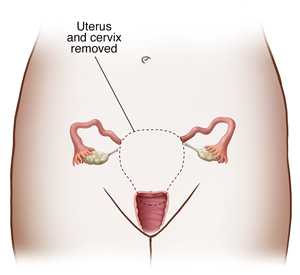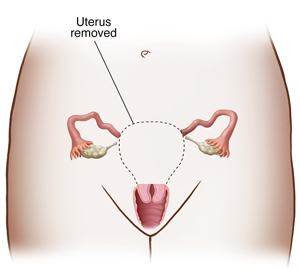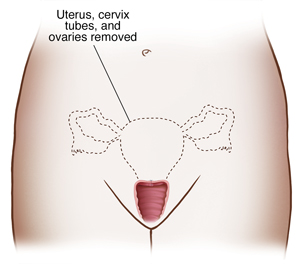Hysterectomy: Surgical Procedures
A hysterectomy is the removal of a female's uterus. It can relieve symptoms such as severe pain and bleeding. If you have cancer, it may save your life. You will discuss what type of surgery you will have with your healthcare provider. This will depend on your health problem. If you have any questions or concerns, let your healthcare provider know.
Reaching the uterus
There are several ways to reach the uterus to remove it. The best approach depends on the reason for your surgery. The three main approaches are described below:
-
Vaginal. An incision is made inside the vagina. The uterus is then removed through this incision. This can be done if the uterus is not too large.
-
Laparoscopic. A thin tube with a camera and a light on the end is used. This is called a laparoscope. The surgeon makes two to four small incisions in the abdomen. The scope is put through one of the incisions. The scope sends live pictures to a video screen. This allows the surgeon to see inside the abdomen. Surgical tools are placed through the other small incisions. The uterus can be removed through these incisions or through an incision made in the vagina. One of the following procedures may be done:
-
The uterus is removed through a small incision in the vagina. This is called LAVH, or laparoscopic assisted vaginal hysterectomy.
-
The uterus is removed through the small incisions in the abdomen. The cervix is left in place. This is called LSH, or laparoscopic subtotal hysterectomy.
-
The uterus and cervix are removed through the small incisions in the abdomen. This is called TLH, or total laparoscopic hysterectomy.
-
During any of these procedures, robotic technique may be used. This assists the surgeon’s vision and hand movements.
Types of hysterectomy
When the uterus is removed, the cervix may be left in place. Or it may also be removed. If it’s removed, the top of the vagina is closed. In certain cases, the ovaries and fallopian tubes are also removed.
-
Removing the uterus. During a total (simple) hysterectomy, the uterus and cervix are removed. During a subtotal hysterectomy, only the uterus is removed. The cervix is left in place. This is also called a supracervical hysterectomy. In either case, the ovaries remain and the fallopian tubes are usually removed to reduce the risk of future cancer related to the fallopian tubes. If you have not yet reached menopause, the ovaries will keep making hormones. You may still feel the changes of menstrual cycles. But you will not have periods and can’t become pregnant.
 |
| Total hysterectomy. |
 |
| Subtotal hysterectomy. |
-
Removing the uterus, ovaries, and tubes. Along with the uterus, the ovaries and fallopian tubes may also be removed. This is called a hysterectomy with salpingo-oophorectomy. It causes the body’s estrogen levels to drop quickly. This is called “surgical” menopause. People who have not reached menopause before surgery may have sudden symptoms. But these symptoms can be treated, most commonly through estrogen replacement therapy.
 |
| Hysterectomy with salpingo-oopherectomy. |
Deciding on hysterectomy
You and your healthcare provider can discuss the best options for you. As you decide, your provider may ask you to think about the following:
-
Is your health problem getting in the way of your daily life? Is the problem getting worse? If not, might other treatments be tried first?
-
Do you want to have children? If so, other treatments should be considered.
-
Should the fallopian tubes be removed, too? This will reduce the chances of ovarian cancer since we now know that many ovarian cancers actually come from the tubes.
-
Should the ovaries be removed, too? This is often done to treat or prevent cancer. If removal is needed, talk with your healthcare provider about estrogen replacement therapy.
Risks and possible complications of a hysterectomy
-
Side effects from the anesthesia
-
Infection
-
Bleeding, with a possible need for transfusion
-
Damage to nearby organs (bladder, bowel, ureters, or nearby nerves or blood vessels)
-
Blood clots in the legs or lungs
-
Formation of scar tissue that may cause pain or bowel obstruction in the future (this is more common with the abdominal approach)
-
Need for second surgery
© 2000-2024 The StayWell Company, LLC. All rights reserved. This information is not intended as a substitute for professional medical care. Always follow your healthcare professional's instructions.